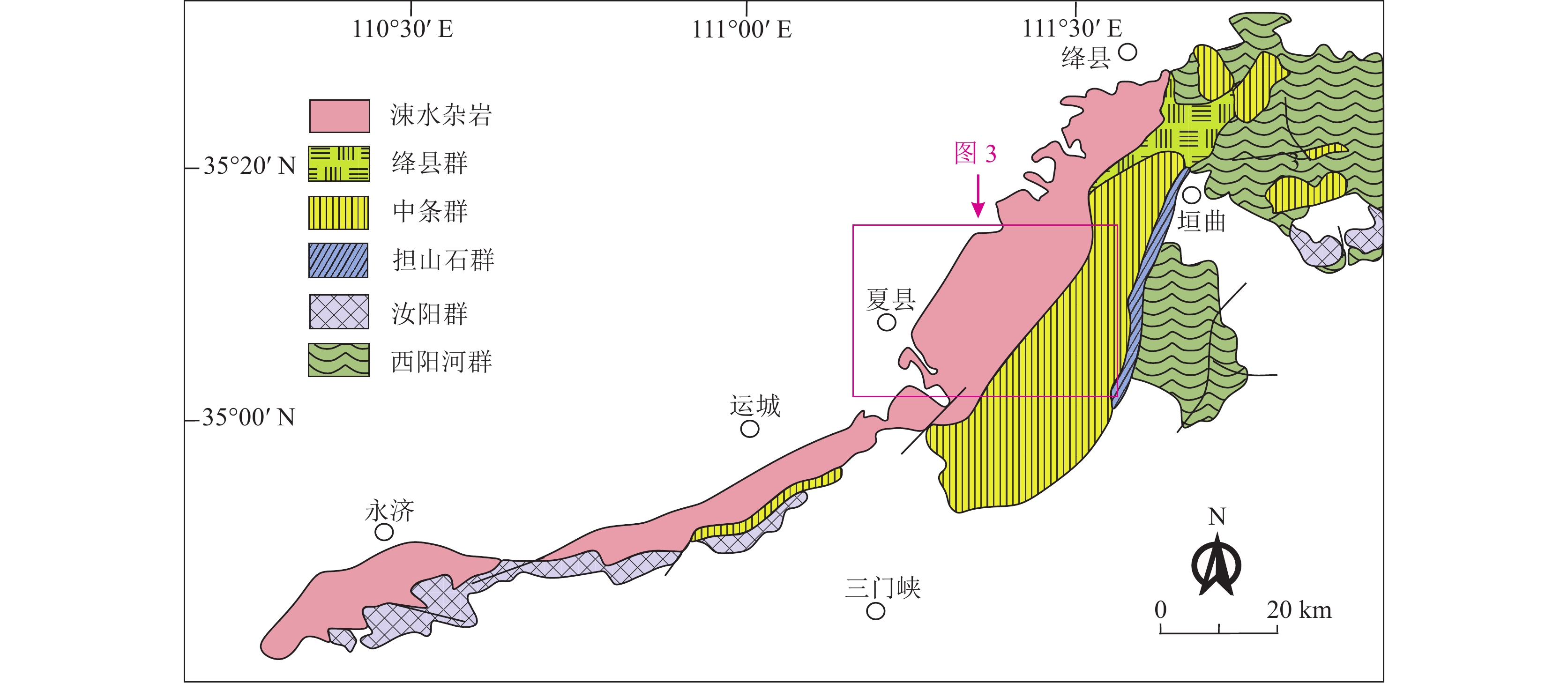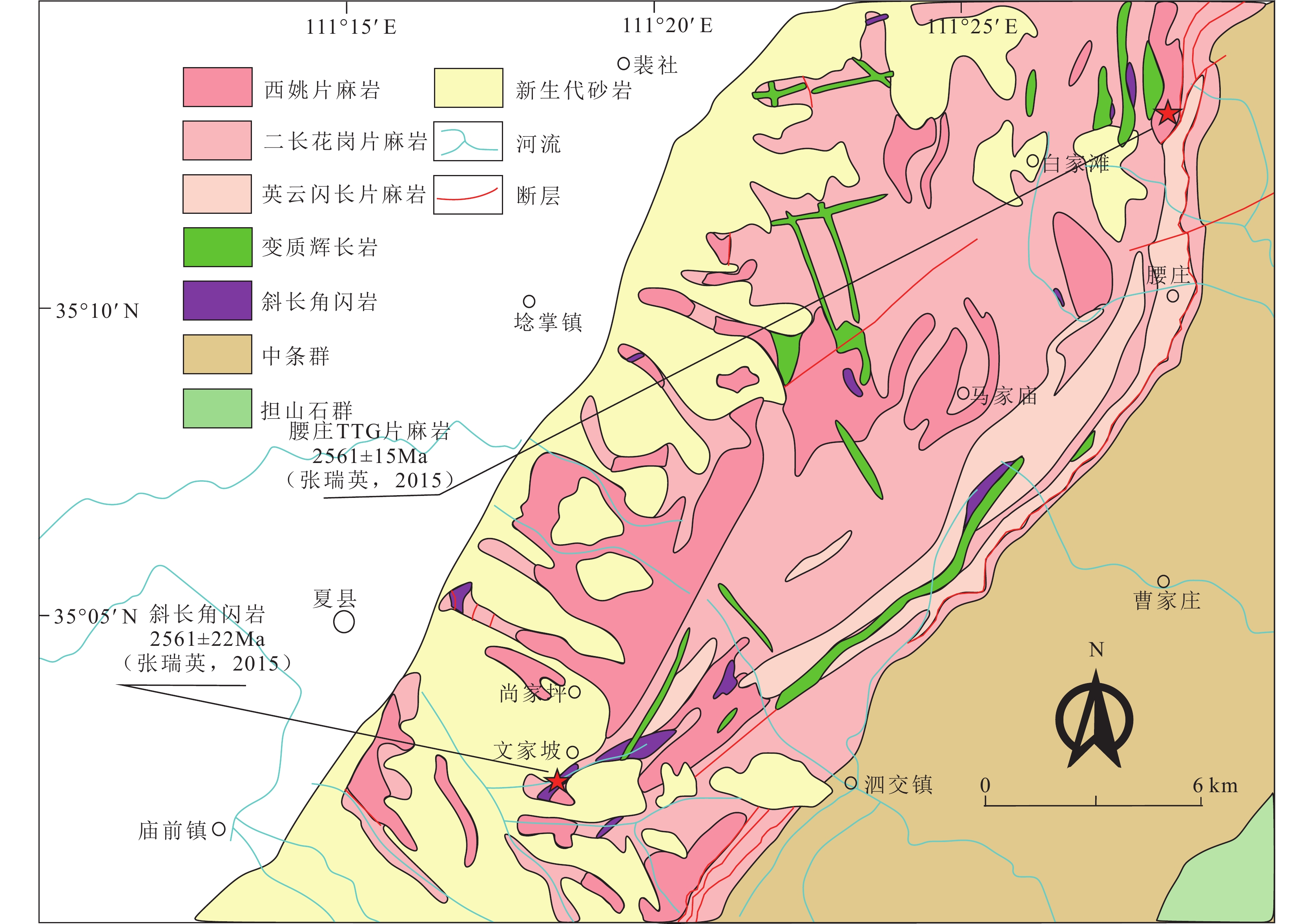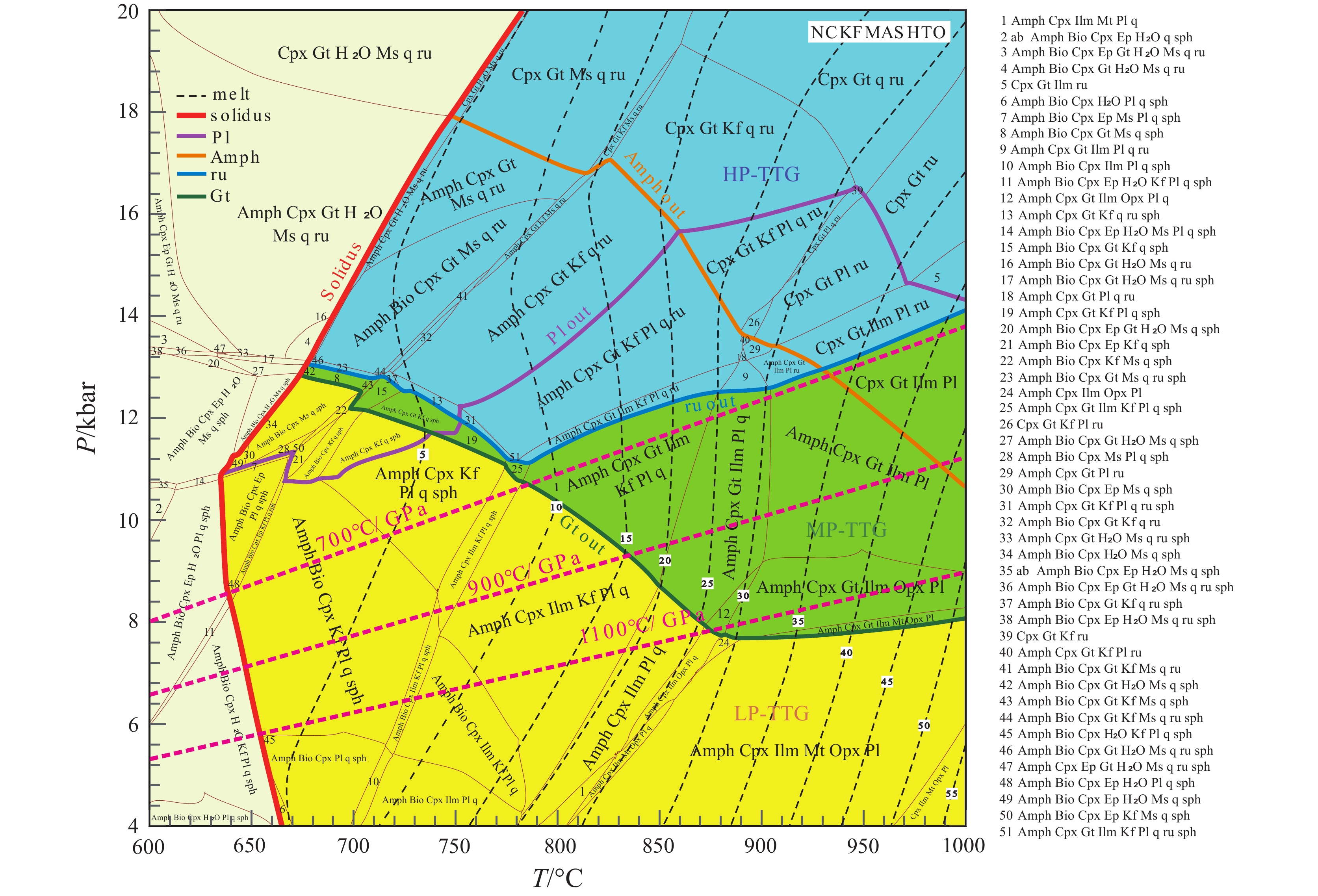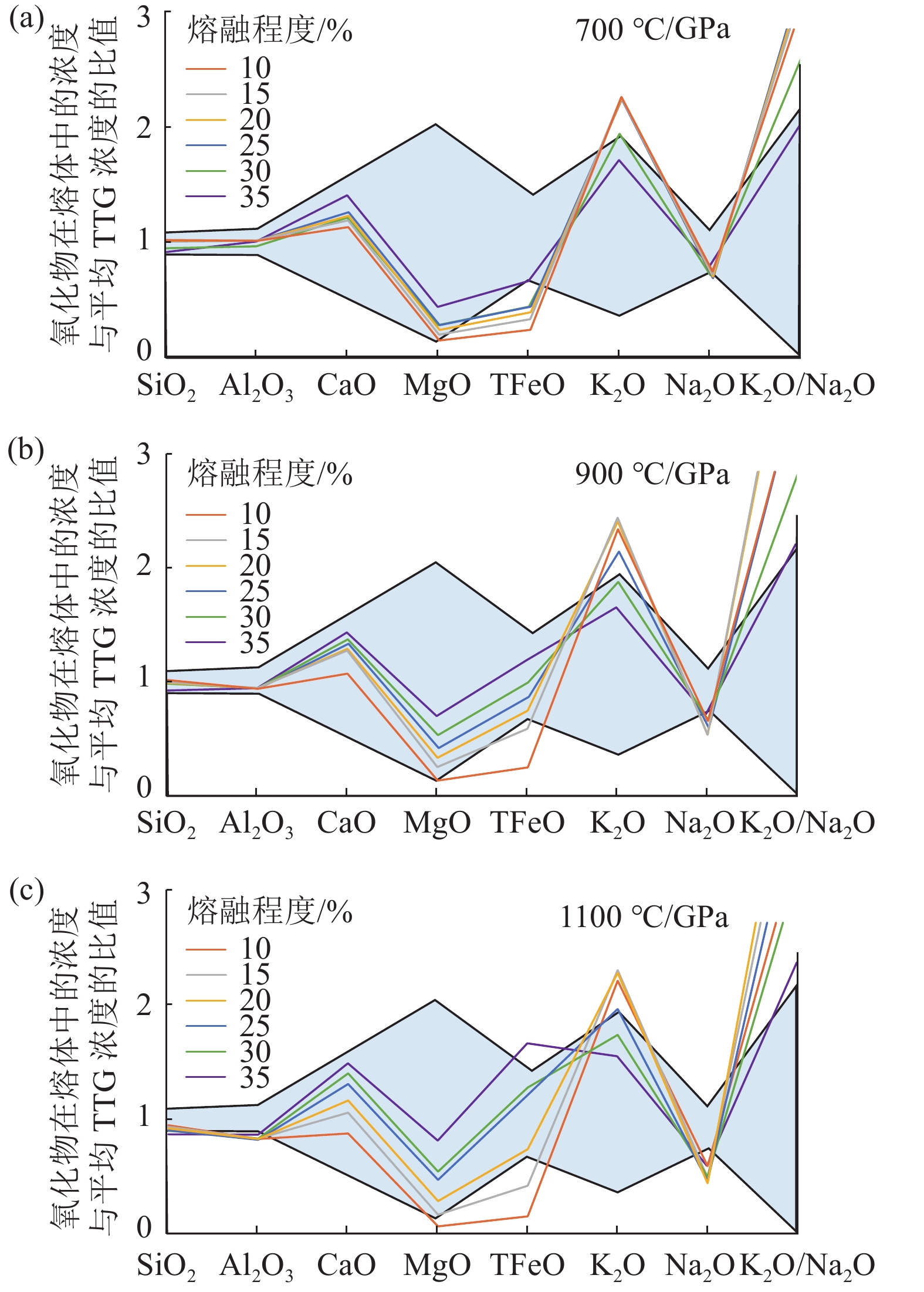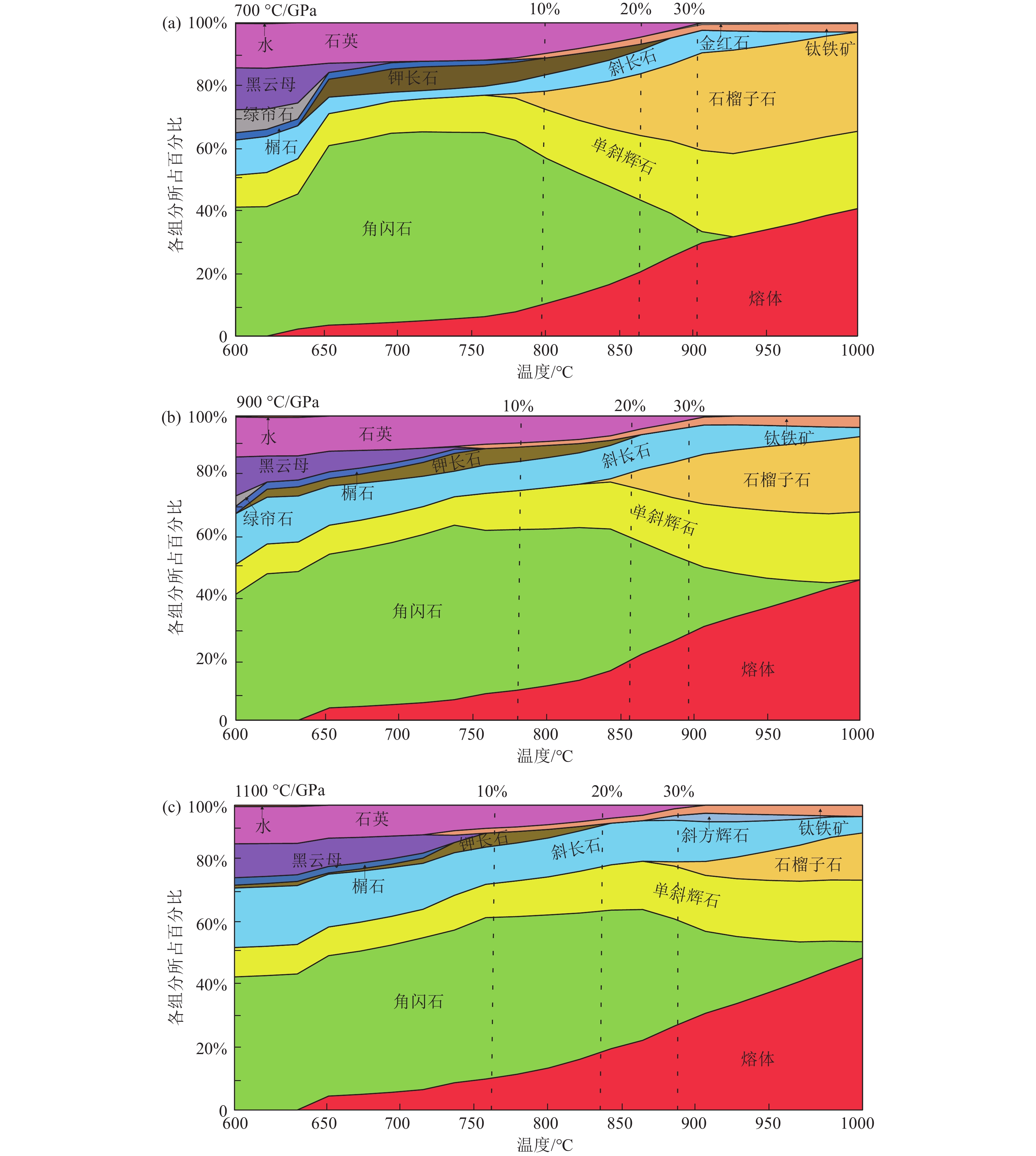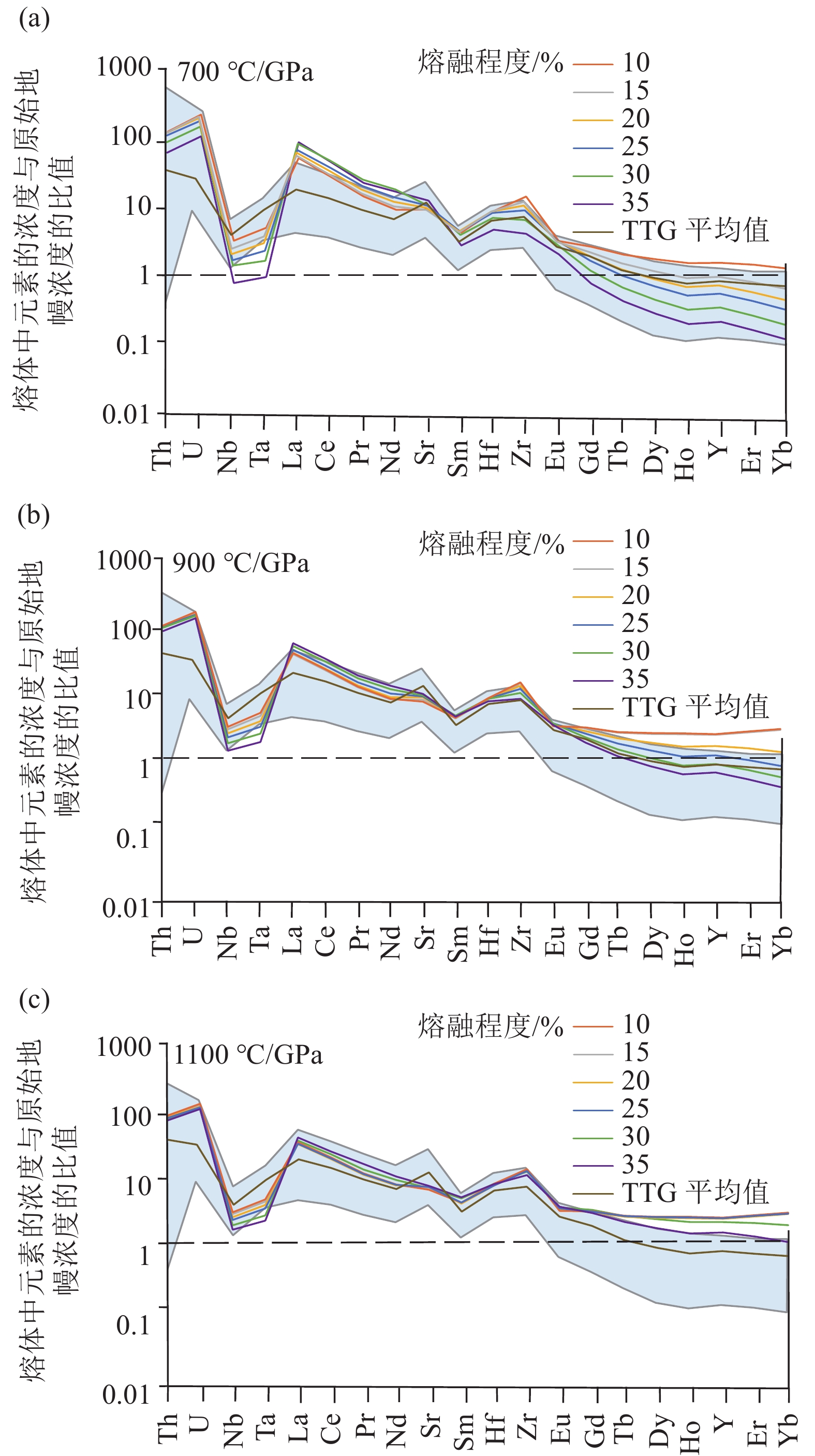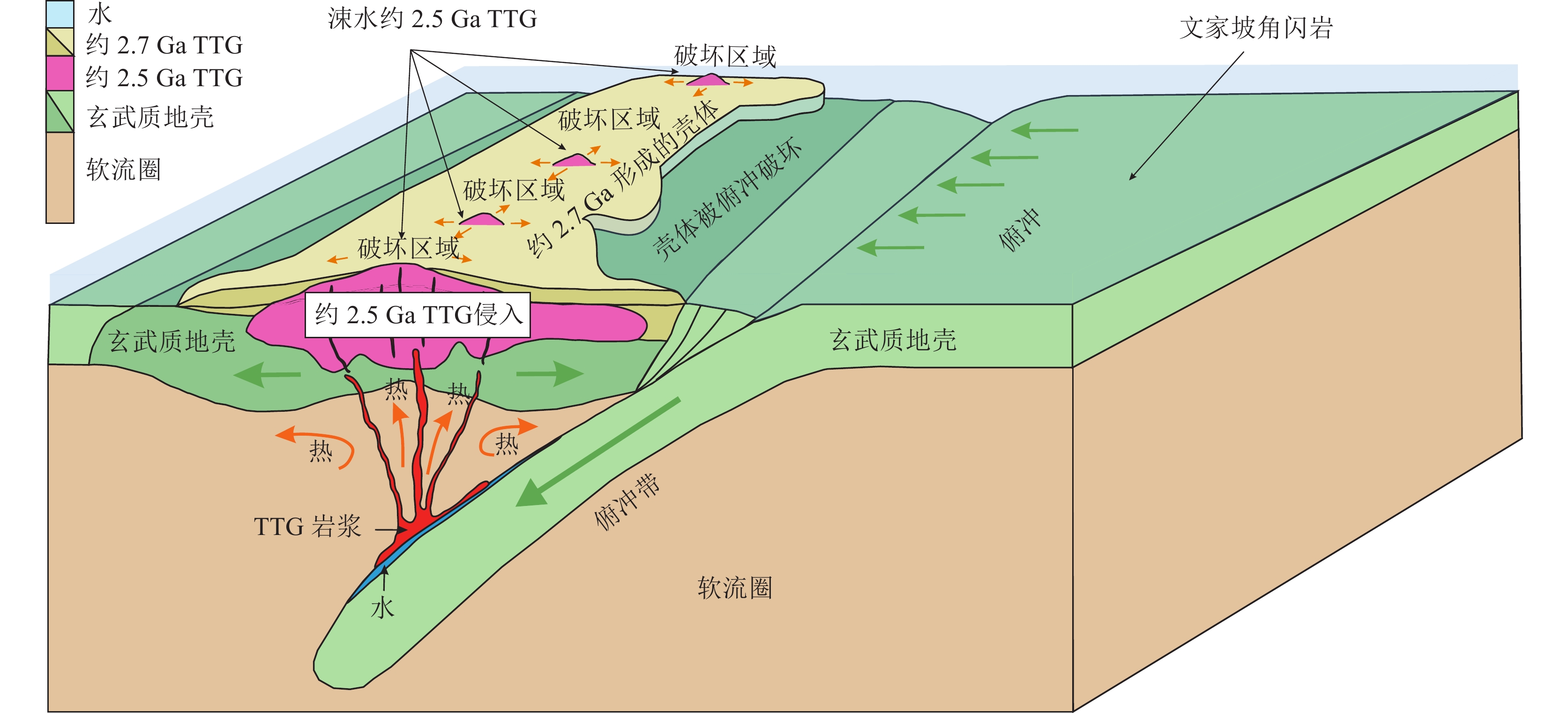Warm subduction origin of 2.5 Ga TTG in Zhongtiao Mountains, Shanxi: Constraints from phase equilibrium modeling
-
摘要:
2.5 Ga左右地球上发生的构造机制转换,是地球演化历史中最重要的地质阶段之一,制约着地球早期大陆生长及克拉通作用的方式。TTG(奥长花岗岩、英云闪长岩、花岗闪长岩岩石组合)作为太古宙大陆地壳主体,探究其形成环境有助于更好地理解太古宙的板块构造动力学机制。但由于TTG含水熔融形成过程中的P-T条件缺失,热力学性质控制的板块构造机制无法被很好地识别。以中条山约2.5 Ga的TTG 为研究对象,选取中条山文家坡约2.5 Ga 的变玄武岩为源岩,对其进行 TTG 岩浆的定量正演模拟计算。发现在900℃/GPa地温梯度下,发生25%的含水熔融能够满足中条山约2.5 Ga TTG 形成条件。据此推测,此类 TTG形成于暖俯冲环境,揭示约2.5 Ga华北克拉通已经存在与地球板块生长事件对应的水平生长机制。同时部分地球化学指标的异常,也揭示构造机制已开始走向类似现代板块构造的趋势。
Abstract:The tectonic transition that occurred around 2.5 Ga represents one of the most significant geological events in Earth's history, shaping the early processes of continental growth and cratonization. As the dominant component of the Archean continental crust, TTGs provide valuable insights into the dynamic mechanisms of Archean plate tectonics. However, the lack of data on the pressure−temperature (P−T) conditions during the water−bearing melting processes of TTGs limits our ability to fully identify the tectonic mechanisms involved. This study investigates the 2.5 Ga TTGs in the Zhongtiao Mountains, using 2.5 Ga metabasalt from Wenjiapo as the source rock. Quantitative forward modeling of TTG magmatism revealed that 25% water−bearing melting at a geothermal gradient of 900℃/GPa satisfies the conditions for the formation of the 2.5 Ga TTGs in the Zhongtiao Mountains. The findings suggest that these TTGs formed in a warm subduction environment, indicating that by 2.5 Ga, the North China Craton had already developed a horizontal growth mechanism, consistent with global plate growth events. Additionally, anomalies in certain geochemical indicators suggest that the tectonic mechanism was beginning to transition toward a modern plate subduction environment.
-
-
图 1 华北克拉通前寒武纪地质体分布图 (据第五春荣, 2021修改)
ZT—中条;LS(LPS)—陇山;XQL—小秦岭;DF—登封;LS—鲁山;HQ—霍邱
Figure 1. Simplified geological map showing the distribution of metamorphic complexes in the NCC
图 2 中条山地质简图 (据白瑾等, 1997修改)
Figure 2. Geological map of the Zhongtiao Mountain region
图 3 中条山夏县地质简图(据侯马市幅I49C001003 1∶25万区域地质图修改;刘成如等,2007)
Figure 3. Regional geological map of the Xiaxian in Zhongtiao Mountain, Shanxi Province
图 4 文家坡变玄武岩P-T相图(黑色虚线表示熔体的质量百分比(%);红色虚线表示地温梯度(°C/GPa);黄色区域表示在低压下产生的熔体组成(LP-TTG),绿色区域表示在中压下产生的熔融组成(MP-TTG),蓝色区域表示在高压下产生的熔化组成(HP-TTG)。高压、中压和低压型TTG的划分根据Moyen (2011) 。斜长石、角闪石、金红石和石榴子石的稳定域界线分别用紫色、橙色、蓝色和绿色线表示,红线表示固相线)
ab—钠长石;Amph—角闪石;Bio—黑云母;Cpx—单斜辉石;Ep—绿帘石;Gt—石榴子石; Kf—钾长石;llm—钛铁矿;Ms—白云母;Mt—磁铁矿;Opx—斜方辉石;Pl—斜长石;q—石英;ru—金红石;sph—榍石;H2O—水;Melt—熔体;Solidus—固相线
Figure 4. Simplified P-T phase diagram for an average of Wenjiapo amphibolite
表 1 源岩地球化学成分(FeO代表全铁含量,Fe3+/ ΣFe = 0.1(mol%))(据Berry et al., 2008)
Table 1 Bulk-rock compositions used for the phase diagram
源岩化学成分 H2O SiO2 Al2O3 CaO MgO FeO K2O Na2O TiO2 O2 数值/mol% 5.535 52.079 7.893 9.894 8.997 10.329 0.968 2.533 1.054 0.717 -
Abbott D. 1995. The structural and geochemical evolution of the continental crust: Support for the oceanic plateau model of continental growth[J]. Reviews of Geophysics, 33: 231−242. doi: 10.1029/95RG00551
Albarède F. 1998. The growth of continental crust[J]. Tectonophysics, 296(1): 1−14.
Arndt N. 2013. Formation and evolution of the continental crust[J]. Geochemical Perspectives, 2(3): 405−533. doi: 10.7185/geochempersp.2.3
Bai J. 1993. The Precambrian geology and Pb−Zn mineralization in the northern margin of North China Platform[M]. Geological Publishing House (China): 1−2, 90−96, 122 (in Chinese with English abstract).
Bai J, Dai F Y, Yan Y Y. 1997. Precambrian crustal evolution of the Zhongtiao Mountains[J]. Earth Science Frontiers (China University of Geosciences, Beijing), 4(3/4): 281−288 (in Chinese with English abstract).
Bédard J H. 2003. Evidence for regional−scale, pluton−driven, high−grade metamorphism in the Archaean Minto block, Northern Superior Province, Canada[J]. The Journal of Geology, 111(2): 183−205. doi: 10.1086/345842
Bédard J H. 2006. A catalytic delamination−driven model for coupled genesis of Archaean crust and sub−continental lithospheric mantle[J]. Geochimica et Cosmochimica Acta, 70(5): 1188−1214. doi: 10.1016/j.gca.2005.11.008
Bédard J H. 2013. How many arcs can dance on the head of a plume? A ‘Comment’ on: A critical assessment of Neoarchean ‘plume only’ geodynamics: Evidence from the Superior province, by Derek Wyman[J]. Precambrian Research, 229: 189−197. doi: 10.1016/j.precamres.2012.05.004
Berry A J, Danyushevsky L V, O Neill H St C, et al. 2008. Oxidation state of iron in komatiitic melt inclusions indicates hot Archaean mantle[J]. Nature, 455(7215): 960−963. doi: 10.1038/nature07377
Brown M. 2006. Duality of thermal regimes is the distinctive characteristic of plate tectonics since the Neoarchean[J]. Geology, 34(11): 961−964. doi: 10.1130/G22853A.1
Brown M. 2014. The contribution of metamorphic petrology to understanding lithosphere evolution and geodynamics[J]. Geoscience Frontiers, 5(4): 553−569. doi: 10.1016/j.gsf.2014.02.005
Brown M, Johnson T. 2018. Secular change in metamorphism and the onset of global plate tectonics[J]. American Mineralogist, 103(2): 181−196. doi: 10.2138/am-2018-6166
Brown M, Johnson T. 2019a. Metamorphism and the evolution of subduction on Earth[J]. American Mineralogist, 104(8): 1065−1082. doi: 10.2138/am-2019-6956
Brown M, Johnson T. 2019b. The 51st Hallimond lecture time's arrow, time's cycle: Granulite metamorphism and geodynamics[J]. Mineralogical Magazine, 83(3): 1−51.
Brown M, Johnson T, Gardiner N J. 2020. Plate tectonics and the Archean Earth[J]. Annual Review of Earth and Planetary Sciences, 48(1): 291−320. doi: 10.1146/annurev-earth-081619-052705
Cawood P A, Hawkesworth C J, Dhuime B. 2013. The continental record and the generation of continental crust[J]. GSA Bulletin, 125(1/2): 14−32. doi: 10.1130/B30722.1
Cawood P A, Hawkesworth C J, Pisarevsky S, et al. 2018. Geological archive of the onset of plate tectonics[J]. Philosophical Transactions of The Royal Society A Mathematical Physical and Engineering Sciences, 376(2132): 20170405. doi: 10.1098/rsta.2017.0405
Cawood P A. 2020. Metamorphic rocks and plate tectonics[J]. Science Bulletin, 65(12): 968−969. doi: 10.1016/j.scib.2020.02.016
Chen L M, Liu P H, Du L L, et al. 2023. Depositional age and provenance of the Anshan Group in the Gongchangling area, Liaoning Province: Constraints from detrital zircon U−Pb−Hf isotopic and rare earth element composition in the garnet−staurolite−mica−quartz schist[J]. Geological Bulletin of China, 42(12): 2037−2059 (in Chinese with English abstract).
Chen S W, Li J H, Yuan F, et al. 2023. Modern−style subduction during the late Neoarchean to early Paleoproterozoic? Geochemical evidence from ca. 2.45 Ga arc−type magmatism in the Feidong Complex, northeastern Yangtze Craton, South China[J]. Precambrian Research, 388(1/2): 106999.
Condie K C. 1975. Mantle−plume model for the origin of Archaean greenstone belts based on trace element distributions[J]. Nature, 258: 413−414. doi: 10.1038/258413a0
Condie K C. 1981. Archaean greenstone belts[J]. Developments in Precambrian Geology, 3: 1−434. doi: 10.1016/S0166-2635(08)70074-4
Condie K C. 1994. Chapter 3: Greenstones through time[J]. Developments in Precambrian Geology, 11: 85−120.
Condie K C. 1995. Episodic ages of Greenstones: A key to mantle dynamics?[J]. Geophysical Research Letters, 22(16): 2215−2218. doi: 10.1029/95GL01804
Condie K C. 1998. Episodic continental growth and supercontinents: A mantle avalanche connection[J]. Earth and Planetary Science Letters, 163(1): 97−108.
Condie K C. 2000. Episodic continental growth models: Afterthoughts and extensions[J]. Tectonophysics, 322(1): 153−162.
Condie K C, Kröner A. 2008. When did plate tectonics begin? Evidence from the geologic record[M]. Boulder: Geological Society of America, 440: 281−294.
Condie K C, Aster R, van Hunen J. 2016. A great thermal divergence in the mantle beginning 2.5 Ga: Geochemical constraints from greenstone basalts and komatiites[J]. Geoscience Frontiers, 7(4): 543−553. doi: 10.1016/j.gsf.2016.01.006
Condie K C, O'Neill C, Aster R C. 2009. Evidence and implications for a widespread magmatic shutdown for 250 My on Earth[J]. Earth and Planetary Science Letters, 282(1): 294−298.
Cui Z X, Xia X P, Huang X L, et al. 2022. Meso− to Neoarchean geodynamic transition of the North China Craton indicated by H2O−in−zircon for TTG suite[J]. Precambrian Research, 371: 106574. doi: 10.1016/j.precamres.2022.106574
Davies G F. 1992. On the emergence of plate tectonics[J]. Geology, 20(11): 963−966. doi: 10.1130/0091-7613(1992)020<0963:OTEOPT>2.3.CO;2
Diwu C R. 2021. Crustal growth and evolution of Archean continental crust in the southern North China Craton[J]. Acta Petrologica Sinica. 37(2): 317−340 (in Chinese with English abstract).
Drummond M S, Defant M J. 1990. A model for trondhjemite−tonalite−dacite genesis and crustal growth via slab melting: Archean to modern comparisons[J]. Journal of Geophysical Research, 95(B13): 21503−21521. doi: 10.1029/JB095iB13p21503
Festa A, Barbero E, Remitti F, et al. 2022. Mélanges and chaotic rock units: Implications for exhumed subduction complexes and orogenic belts[J]. Geosystems and Geoenvironment, 1(2): 100030. doi: 10.1016/j.geogeo.2022.100030
Fischer R, Gerya T. 2016. Regimes of subduction and lithospheric dynamics in the Precambrian: 3D thermomechanical modelling[J]. Gondwana Research, 37(B7): 53−70.
Foley S, Tiepolo M, Vannucci R. 2002. Growth of early continental crust controlled by melting of amphibolite in subduction zones[J]. Nature, 417: 837−840. doi: 10.1038/nature00799
Fu J H, Liu S W, Zhang B, et al. 2019. A Neoarchean K−rich granitoid belt in the northern North China Craton[J]. Precambrian Research, 328: 193−216. doi: 10.1016/j.precamres.2019.04.021
Furnes H, Wit M J, Staudigel H, et al. 2007. A vestige of Earth's oldest ophiolite[J]. Science, 315: 1704−1707.
Furnes H, Dilek Y. 2021. Archean versus Phanerozoic oceanic crust formation and tectonics: Ophiolites through time[J]. Geosystems and Geoenvironment, 1(1): 100004.
Geng Y S, Du L L, Ren L D. 2012. Growth and reworking of the early Precambrian continental crust in the North China Craton: Constraints from zircon Hf isotopes[J]. Gondwana Research, 21(2): 517−529.
Green E C R, White R, Diener J F A, et al. 2016. Activity–composition relations for the calculation of partial melting equilibria in metabasic rocks[J]. Journal of Metamorphic Geology, 34(9): 845−869. doi: 10.1111/jmg.12211
Guiraud M, Powell R, Rebay G. 2001. H2O in metamorphism and unexpected behaviour in the preservation of metamorphc mineral assemblages[J]. Journal of Metamorphic Geology, 19: 445−454. doi: 10.1046/j.0263-4929.2001.00320.x
Guitreau M. 2012. Les isotopes de l'hafnium dans les TTG et leurs zircons: témoins de la croissance des premiers continents[Z]. Lyon: Ecole normale supérieure de lyon.
Guo L S, Liu S W, Liu Y L, et al. 2008. Zircon Hf isotopic features of TTG gneisses and formation environment of Precambrian Sushui complex in Zhongtiao mountains[J]. Acta Petrologica Sinica, 24(1): 139−148 (in Chinese with English abstract).
Hamilton W B. 2011. Plate tectonics began in Neoproterozoic time, and plumes from deep mantle have never operated[J]. Lithos, 123(1): 1−20.
Hartnady M I H, Johnson T, Schorn S, et al. 2022. Fluid processes in the early Earth and the growth of continents[J]. Earth and Planetary Science Letters, 594(B1): 117695.
Heilimo E, Halla J, Hölttä P. 2010. Discrimination and origin of the sanukitoid series: Geochemical constraints from the Neoarchean western Karelian Province (Finland)[J]. Lithos, 115(1): 27−39.
Herzberg C, Condie K C, Korenaga J. 2010. Thermal history of the Earth and its petrological expression[J]. Earth and Planetary Science Letters, 292(1): 79−88.
Holder R M, Viete D R, Brown M, et al. 2019. Metamorphism and the evolution of plate tectonics[J]. Nature, 572(7769): 378−381. doi: 10.1038/s41586-019-1462-2
Holland T J B, Powell R. 2003. Activity−composition relations for phases in petrological calculations: an asymmetric multicomponent formulation[J]. Contributions to Mineralogy and Petrology, 145: 492−501. doi: 10.1007/s00410-003-0464-z
Holland T J B, Powell R. 2011. An improved and extended internally consistent thermodynamic dataset for phases of petrological interest, involving a new equation of state for solids[J]. Journal of Metamorphic Geology, 29: 333−383. doi: 10.1111/j.1525-1314.2010.00923.x
Huang B, Kusky T M, Johnson T, et al. 2020. Paired metamorphism in the Neoarchean: A record of accretionary−to−collisional orogenesis in the North China Craton[J]. Earth and Planetary Science Letters, 543: 116355. doi: 10.1016/j.jpgl.2020.116355
Huang B, Johnson T, Wilde S A, et al. 2022. Coexisting divergent and convergent plate boundary assemblages indicate plate tectonics in the Neoarchean[J]. Nature Communications, 13(1): 6450. doi: 10.1038/s41467-022-34214-8
Huang D M, Dong C Y, Wan Y S. 2020. Late Neoarchean−Late Paleoproterozoic magmato−tectonothermal events in the Xiaoqinling Area, southern margin of the North China Craton, as documented by zircon U−Pb−Hf isotope analyses and whole−rock geochemistry[J]. Earth Science, 45(9): 3330−3340(in Chinese with English abstract).
Huang J F, Zheng C Q, Liang C Y, et al. 2024. Petrogenetic mechanism of Neoarchean charnockitic gneiss in Tangtu, northern Liaoning Province[J]. Geological Bulletin of China. DOI: 10.12097/gbc.2024.08.007(in Chinese with English abstract).
Jahn B M, Glikson A Y, Peucat J J, et al. 1981. REE geochemistry and isotopic data of Archean silicic volcanics and granitoids from the Pilbara Block, Western Australia: Implications for the early crustal evolution[J]. Geochimica et Cosmochimica Acta, 45(9): 1633−1652. doi: 10.1016/S0016-7037(81)80002-6
Jenner F E, Bennett V C, Nutman A P, et al. 2009. Evidence for subduction at 3.8 Ga: Geochemistry of arc−like metabasalts from the southern edge of the Isua Supracrustal Belt[J]. Chemical Geology, 261(1): 83−98.
Jiao D C, Qu J F. 2023. Warm subduction−driven formation of ~2.7 Ga TTG gneiss in the Zhongtiao Mountains, Southern North China Craton: Constraints from phase equilibrium modeling[J]. The Journal of Geology, 131(2): 113−126. doi: 10.1086/727973
Jin W, Tian Y, Wang J, et al. 2022. New discovery of Neoarchean inherited zircon (2.65 Ga) in the Cretaceous granite from the North Dabie[J]. Geology in China, 49(1): 341−343(in Chinese with English abstract).
Kamber B S. 2015. The evolving nature of terrestrial crust from the Hadean, through the Archaean, into the Proterozoic[J]. Precambrian Research, 258: 48−82. doi: 10.1016/j.precamres.2014.12.007
Kankanamge D G J, Moore W B. 2019. A parameterization for volcanic heat flux in Heat Pipe Planets[J]. Journal of Geophysical Research: Planets, 124(1): 114−127. doi: 10.1029/2018JE005800
Korenaga J. 2012. Initiation and evolution of plate tectonics on Earth: Theories and observations[J]. Annual Review of Earth and Planetary Sciences, 41: 177−151.
Kusky T M, Li J H. 2003. Paleoproterozoic tectonic evolution of the North China Craton[J]. Journal of Asian Earth Sciences, 22(4): 383−397. doi: 10.1016/S1367-9120(03)00071-3
Li L, Zhai W J. 2019. Geochemistry and Petrogenesis of the ca. 2.5 Ga High−K Granitoids in the Southern North China Craton[J]. Journal of Earth Science, 30(3/4): 1−19.
Li S Z, Dai L M, Zhang Z, et al. 2015. Precambrian geodynamics (III): General features of Precambrian geology[J]. Geoscience Frontiers, 22(6): 27−45(in Chinese with English abstract).
Li X Y, Zhang C, Almeev R, et al. 2020. GeoBalance: An Excel VBA program for mass balance calculation in geosciences[J]. Geochemistry, 80(2): 125629. doi: 10.1016/j.chemer.2020.125629
Liou P, Wang Z C, Mitchell R N, et al. 2022. Fe isotopic evidence that “high pressure” TTGs formed at low pressure[J]. Earth and Planetary Science Letters, 592: 117645. doi: 10.1016/j.jpgl.2022.117645
Liu B, Ma J X, Li P F, et al. 2024. First boron isotopes in the southern Jilin TTG series uncover a Neoarchean oceanic arc in the eastern North China Craton[J]. Gondwana Research. DOI: https://doi.org/10.1016/j.gr.2024.11.008.
Liu L, Kang S S, Liu H, et al. 2023. Formation and evolution of Archean TTG in southeastern North China Craton[J]. Geological Review, 69(1): 49−75 (in Chinese with English abstract).
Liu C R, Xue W Y, Li J R, et al. 2007. A regional geological survey report with the number I49C001003 and a scale of 1∶250,000 for Houma City[DS]. National Geological Archives of China, DOI:10.35080/n01.c.123489 (in Chinese).
Liu S W, Wang W, Bai X, et al. 2018. Lithological assemblages of Archean Meta−Igneous Rocks in Eastern Hebei−Western Liaoning Provinces of North China Craton, and Their Geodynamic Implications[J]. Earth Science, 43(1): 44−56(in Chinese with English abstract).
Martin E, Martin H, Sigmarsson O. 2008. Could Iceland be a modern analogue for the Earth’s early continental crust[J]. Terra Nova, 20(6): 463−468. doi: 10.1111/j.1365-3121.2008.00839.x
Martin H. 1987. Petrogenesis of Archaean trondhjemites, tonalites, and granodiorites from Eastern Finland: Major and trace element geochemistry[J]. Journal of Petrology, 28(5): 921−953. doi: 10.1093/petrology/28.5.921
Martin H. 1999. Adakitic magmas: modern analogues of Archaean granitoids[J]. Lithos, 46(3): 411−429. doi: 10.1016/S0024-4937(98)00076-0
Martin H, Moyen J. 2002. Secular changes in TTG composition as markers of the progressive cooling of the Earth[J]. Geology, 30(4): 319−322. doi: 10.1130/0091-7613(2002)030<0319:SCITTG>2.0.CO;2
Martin H, Moyen J, Guitreau M, et al. 2014. Why Archaean TTG cannot be generated by MORB melting in subduction zones[J]. Lithos, 198−199: 1−13. doi: 10.1016/j.lithos.2014.02.017
Moyen J, Stevens G, Kisters A. 2006. Record of Mid−Archaean subduction from metamorphism in the Barberton Terrain, South Africa[J]. Nature, 442(7102): 559−562. doi: 10.1038/nature04972
Moyen J. 2011. The composite Archaean grey gneisses: Petrological significance, and evidence for a non−unique tectonic setting for Archaean crustal growth[J]. Lithos, 123(1): 21−36.
Moyen J, Martin H. 2012. Forty years of TTG research[J]. Lithos, 148: 312−336. doi: 10.1016/j.lithos.2012.06.010
Nair R, Chacko T. 2008. Role of oceanic plateaus in the initiation of subduction and origin of continental crust[J]. Geology, 36(7): 583−586. doi: 10.1130/G24773A.1
Palin R M, White R, Green E C R. 2016. Partial melting of metabasic rocks and the generation of tonalitic–trondhjemitic–granodioritic (TTG) crust in the Archaean: Constraints from phase equilibrium modelling[J]. Precambrian Research, 287: 73−90. doi: 10.1016/j.precamres.2016.11.001
Palin R M, Santosh M. 2021. Plate tectonics: What, where, why, and when?[J]. Gondwana Research, 100(10): 3−24.
Powell R, Holland T J B. 1988. An internally consistent dataset with uncertainties and correlations: 3. Applications to geobarometry, worked examples and a computer program[J]. Journal of Metamorphic Geology, 6(2): 173−204. doi: 10.1111/j.1525-1314.1988.tb00415.x
Prouteau G, Scaillet B, Pichavant M, et al. 2001. Evidence for mantle metasomatism by hydrous silicic melts derived from subducted oceanic crust[J]. Nature, 410(6825): 197−200. doi: 10.1038/35065583
Rapp R P, Watson E B, Miller C F. 1991. Partial melting of amphibolite/eclogite and the origin of Archean trondhjemites and tonalites[J]. Precambrian Research, 51(1): 1−25.
Rapp R P, Norman M, Laporte D, et al. 2010. Continent formation in the Archean and chemical evolution of the Cratonic Lithosphere: Mel−rock reaction experiments at 3−4 GPa and petrogenesis of Archean Mg−diorites[J]. Journal of Petrology, 51(6): 1237−1266. doi: 10.1093/petrology/egq017
Rollinson H. 1993. Using geochemical data: Evaluation, presentation, interpretation[M]. London: Routledge.
Rozel A B, Golabek G J, Jain C, et al. 2017. Continental crust formation on early Earth controlled by intrusive magmatism[J]. Nature, 545(7654): 332−335. doi: 10.1038/nature22042
Shan H X, Zhai M G, Lu X P. 2022. Petrogenesis delineation of the felsic intrusive rocks in the eastern North China Craton: Implications for crustal evolution and geodynamic regimes[J]. Lithos, 422/423(5): 106728.
Sizova E, Gerya T, Brown M, et al. 2010. Subduction styles in the Precambrian: Insight from numerical experiments[J]. Lithos, 116(3): 209−229.
Smithies R H. 2000. The Archaean tonalite–trondhjemite–granodiorite (TTG) series is not an analogue of Cenozoic adakite[J]. Earth and Planetary Science Letters, 182(1): 115−125. doi: 10.1016/S0012-821X(00)00236-3
Sotiriou P, Polat A, Windley B, et al. 2023. Temporal variations in the incompatible trace element systematics of Archean TTGs: Implications for crustal growth and tectonic processes in the early Earth[J]. Earth−Science Reviews, 236: 104274. doi: 10.1016/j.earscirev.2022.104274
Springer W, Seck H A. 1997. Partial fusion of basic granulites at 5 to 15 kbar: Implications for the origin of TTG magmas[J]. Contributions to Mineralogy and Petrology, 127(1): 30−45.
Stein M, Hofmann A W. 1994. Mantle plumes and episodic crustal growth[J]. Nature, 372(6501): 63−68. doi: 10.1038/372063a0
Stern R J. 2006. Evidence from ophiolites, blueschists, and ultrahigh−pressure metamorphic terranes that the modern episode of subduction tectonics began in Neoproterozoic time: Comment and Reply[J]. Geology, 34(1): 105−106.
Stern R J, Gerya T, Tackley P J. 2018. Stagnant lid tectonics: Perspectives from silicate planets, dwarf planets, large moons, and large asteroids[J]. Geoscience Frontiers, 9(1): 103−119. doi: 10.1016/j.gsf.2017.06.004
Sun D Z, Li H M, Lin Y X, et al. 1991. Precambrian geochronology, chronotectonic framework and model of chronocrustal structure of the Zhongtiao mountains[J]. Acta Geologica Sinica, 3: 216−231 (in Chinese with English abstract).
Sun G Z, Liu S W, Wang M J, et al. 2020. Complex Neoarchean mantle metasomatism: Evidence from sanukitoid diorites−monzodiorites−granodiorites in the northeastern North China Craton[J]. Precambrian Research, 342(3/4): 105692.
Sun G Z. 2021. Meso− to Neoarchean granitoids and lithospheric thermal state in the Eastern North China Craton [D]. Doctor Thesis of Peking University (China) (in Chinese with English abstract).
Sun Y, Yu Z P. 1988. Geochemistry of archean Shushui complex[J]. Geochimica, 4: 319−325 (in Chinese with English abstract).
Tamblyn R, Hermann J, Hasterok D, et al. 2023. Hydrated komatiites as a source of water for TTG formation in the Archean[J]. Earth and Planetary Science Letters, 603: 117982. doi: 10.1016/j.jpgl.2022.117982
Tang C A, Webb A A G, Moore W B, et al. 2020. Breaking Earth’s shell into a global plate network[J]. Nature Communications, 11(1): 3621. doi: 10.1038/s41467-020-17480-2
Tang L Z. 1996. Division and Correlation of Archean Metamorphic Rock Units in the South−West of Zhongtiao Mountains[J]. North China Journal of Geology and Mineral Resources, 3: 131−136 (in Chinese with English abstract).
Tian G, Yang M H, Song L J, et al. 2023. Late Neoarchean plate subduction in Western North China Craton: Evidence from ca. 2.51 Ga to 2.46 Ga basement rocks in Northern Ordos Basin[J]. Precambrian Research, 387: 106979. doi: 10.1016/j.precamres.2023.106979
Tian W, Liu S W, Liu C H, et al. 2005. Zircon chronology and geochemistry of a series of rocks in the Zhongtiao Mountain Sushui Hybrid Rocks and their geological significance[J]. Progress in Natural Science. 12: 1476−1484 (in Chinese).
van Hunen J, Moyen J. 2012. Archean Subduction: Fact or Fiction?[J]. Annual Review of Earth and Planetary Sciences, 40(1): 195−219. doi: 10.1146/annurev-earth-042711-105255
van Hunen J, van den Berg A P. 2008. Plate tectonics on the early Earth: Limitations imposed by strength and buoyancy of subducted lithosphere[J]. Lithos, 103(1): 217−235.
Wan Y S, Wang S J, Liu D Y, et al. 2012. Redefinition of depositional ages of Neoarchean supracrustal rocks in western Shandong Province, China: SHRIMP U–Pb zircon dating[J]. Gondwana Research, 21(4): 768−784. doi: 10.1016/j.gr.2011.05.017
Wan Y S, Xie S W, Yang C H, et al. 2014. Early Neoarchean (~2.7 Ga) tectono−thermal events in the North China Craton: A synthesis[J]. Precambrian Research, 247: 45−63. doi: 10.1016/j.precamres.2014.03.019
Wan Y S, Dong C Y, Ren P, et al. 2017. Spatial and temporal distribution, compositional characteristics and formation and evolution of Archean TTG rocks in the North China Craton: A synthesis[J]. Acta Petrologica Sinica; 33(5): 1405−1419(in Chinese with English abstract).
Wang C, Song S G, Su L, et al. 2022. Crustal maturation and cratonization in response to Neoarchean continental collision: The Suizhong granitic belt, North China Craton[J]. Precambrian Research, 377: 106732. doi: 10.1016/j.precamres.2022.106732
Wang W, Liu S W, Santosh M, et al. 2015. Neoarchean intra−oceanic arc system in the Western Liaoning Province: Implications for Early Precambrian crustal evolution in the Eastern Block of the North China Craton[J]. Earth−Science Reviews, 150: 329−364. doi: 10.1016/j.earscirev.2015.08.002
Wang X, Zhang J, Liu J, et al. 2024. Geochemistry and geochronology of the TTG−sanukitoid suite in the Zhulagou area: Constraints on the Neoarchean crustal evolution of the western North China Craton[J]. Lithos, 478−479: 107636. doi: 10.1016/j.lithos.2024.107636
Wang Y Q, Dong C Y, Wilde S A, et al. 2025. The Neoarchean granitoids in the Yanlingguan area, western Shandong, North China Craton record the transition from TTG to K−rich granitoids[J]. Precambrian Research, 417: 107633. doi: 10.1016/j.precamres.2024.107633
White R, Palin R M, Green E C R. 2016. High−grade metamorphism and partial melting in Archean composite grey gneiss complexes[J]. Journal of Metamorphic Geology, 35: 181−195.
White R, Powell R, Clarke G. 2002. The Interpretation of reaction textures in Fe−rich metapelitic granulites of the Musgrave Block, central Australia: Constraints from mineral equilibria calculations in the system K2O−FeO−MgO−Al2O3−SiO2−H2O−TiO2−Fe2O3[J]. Journal of Metamorphic Geology, 20(1): 41−55. doi: 10.1046/j.0263-4929.2001.00349.x
White R, Powell R, Holland T J B, et al. 2000. The effect of TiO2 and Fe2O3 on metapelitic assemblages at greenschist and amphibolite facies conditions: Mineral equilibria calculations in the system K2O−FeO−MgO−Al2O3−SiO2−H2O−TiO2−Fe2O3[J]. Journal of Metamorphic Geology, 18: 497−512. doi: 10.1046/j.1525-1314.2000.00269.x
Wicander R, Monroe J S. 2007. Historical geology: evolution of Earth and life through time[M]. Stanford: Cengage Learning.
Wiemer D, Schrank C E, Murphy D T, et al. 2018. Earth's oldest stable crust in the Pilbara Craton formed by cyclic gravitational overturns[J]. Nature Geoscience, 11(5): 357−361. doi: 10.1038/s41561-018-0105-9
Willbold M, Hegner E, Stracke A, et al. 2009. Continental geochemical signatures in dacites from Iceland and implications for models of early Archaean crust formation[J]. Earth and Planetary Science Letters, 279(1): 44−52.
Windley B F, Kusky T M, Polat A. 2021. Onset of plate tectonics by the Eoarchean[J]. Precambrian Research, 352: 105980. doi: 10.1016/j.precamres.2020.105980
Winther K T, Newton R C. 1991. Experimental melting of hydrous low−K tholeiite: evidence onthe origin of Archaean cratons[J]. Copenhagen: Bulletin of the Geological Society of Denmark, 33: 213−288.
Wolf M B, Wyllie P J. 1994. Dehydration−melting of amphibolite at 10 kbar: the effects of temperature and time[J]. Contributions to Mineralogy & Petrology, 115(4): 369−383.
Wu Z Q, Zhao G C. 2022. Hydrous plumes in the Archean and the origin of continents[J]. Science Bulletin, 67(20): 2023−2025. doi: 10.1016/j.scib.2022.09.016
Xiang H, Connolly J. 2021. GeoPS: An interactive visual computing tool for thermodynamic modelling of phase equilibria[J]. Journal of Metamorphic Geology, 40(2): 243−255.
Xiong X, Keppler H, Audetat A, et al. 2011. Partitioning of Nb and Ta between rutile and felsic melt and the fractionation of Nb/Ta during partial melting of hydrous metabasalt[J]. Geochimica et Cosmochimica Acta, 75(7): 1673−1692. doi: 10.1016/j.gca.2010.06.039
Xu X F, Gou L L, Long X P, et al. 2021. Phase equilibrium and trace−element modeling of the partial melting of basaltic rocks under low pressure: Implications for plagiogranite generation[J]. Journal of Petrology, 62(11): 1−29.
Yang C H, Du L L, Song H X, et al. 2020. Geochronology and petrogenesis of Neoarchean Yanzhuang syenogranites from Sushui Complex in the Zhongtiao Mountains: Implications for the crustal evolution of the North China Craton[J]. Earth Science, 45(9): 3161−3178 (in Chinese with English abstract).
Zhai M G, Bian A G. 2000. North China craton, late Neo−Archean supercontinent stitching and late Paleoproterozoic−MesoProterozoic splitting[J]. Science in China, 30(S1): 129−137 (in Chinese).
Zhai M G, Santosh M. 2011. The early Precambrian odyssey of the North China Craton: A synoptic overview[J]. Gondwana Research, 20(1): 6−25. doi: 10.1016/j.gr.2011.02.005
Zhai M G. 2015. Multi−stage crustal growth and cratonization of the North China Craton[J]. Geoscience Frontiers, 5(4): 457−469.
Zhai M G, Peng P. 2020a. Origin of early continents and beginning of plate tectonics[J]. Science Bulletin, 65(12): 970−973. doi: 10.1016/j.scib.2020.03.022
Zhai M G, Zhao L, Zhu X Y, et al. 2020b. Review and overview for the frontier hotspot: Early continents and start of plate tectonics[J]. Acta Petrologica Sinica, 36(8): 2249−2275. doi: 10.18654/1000-0569/2020.08.01
Zhang C, Holtz F, Koepke J, et al. 2013. Constraints from experimental melting of amphibolite on the depth of formation of garnet−rich restites, and implications for models of Early Archean crustal growth[J]. Precambrian Research, 231: 206−217. doi: 10.1016/j.precamres.2013.03.004
Zhang F, Liu J T. 1998. Greenstone petro−tectonic frameworkof cratonic basement, North China [C]. Beijing: Chinese Journal of Geophysics.
Zhang G W, Bai Y B, Sun Y, et al. 1985. Composition and evolution of the archaean crust in central Henan, China[J]. Precambrian Research, 27(1): 7−35.
Zhang R Y. 2015. The composition and evolution of the Sushui complex in the Zhongtiao Mountains, the south of North China Craton[D]. Doctor Thesis of Northwest University (China) (in Chinese with English abstract).
Zhang Z J, Kusky T M, Gao M, et al. 2023. Spatio−temporal analysis of big data sets of detrital zircon U−Pb geochronology and Hf isotope data: Tests of tectonic models for the Precambrian evolution of the North China Craton[J]. Earth−Science Reviews, 239(3): 104372.
Zhao B, Wang D H, Hou K J, et al. 2012. Isochronology study on Sushui Complex in Zhongtiao Mountains and its geological significance[J]. Journal of Earth Sciences and Environment, 34(1): 1−8.
Zhao G C, Wilde S A, Cawood P A, et al. 1998. Thermal Evolution of Archean Basement Rocks from the Eastern Part of the North China Craton and Its Bearing on Tectonic Setting[J]. International Geology Review, 40(8): 706−721. doi: 10.1080/00206819809465233
Zhao G C, Zhai M G. 2013. Lithotectonic elements of Precambrian basement in the North China Craton: Review and tectonic implications[J]. Gondwana Research, 23(4): 1207−1240. doi: 10.1016/j.gr.2012.08.016
Zhao G C, Zhang G W. 2021. Origin of continents[J]. Acta Geologica Sinica. 95(1): 1−19 (in Chinese with English abstract).
Zheng Y F, Chen R X. 2017. Regional metamorphism at extreme conditions: Implications for orogeny at convergent plate margins[J]. Journal of Asian Earth Sciences, 145: 46−73. doi: 10.1016/j.jseaes.2017.03.009
Zheng Y F, Zhao G C. 2020. Two styles of plate tectonics in Earth’s history[J]. Science Bulletin, 65(4): 329−334. doi: 10.1016/j.scib.2018.12.029
Zhou Y Y, Zhao T P, Zhai M G, et al. 2014. Petrogenesis of the Archean tonalite–trondhjemite–granodiorite (TTG) and granites in the Lushan area, southern margin of the North China Craton: Implications for crustal accretion and transformation[J]. Precambrian Research, 255(2): 514−537.
Zhu X Y, Zhai M G, Chen F, et al. 2013. ~2.7 Ga Crustal Growth in the North China Craton: Evidence from Zircon U−Pb Ages and Hf Isotopes of the Sushui Complex in the Zhongtiao Terrane[J]. The Journal of Geology, 121(3): 239−254. doi: 10.1086/669977
白瑾. 1993. 华北陆台北缘前寒武纪地质及铅锌成矿作用[M]. 北京: 地质出版社. 白瑾, 戴凤岩, 颜耀阳. 1997. 中条山前寒武纪地壳演化[J]. 地学前缘, Z2: 285−286. 陈丽梅, 刘平华, 杜利林, 等. 2023. 辽宁弓长岭鞍山群时代与物源——来自石榴十字云母片岩碎屑锆石U−Pb−Hf同位素特征与稀土元素组成的约束[J]. 地质通报, 42(12): 2037−2059. 第五春荣. 2021. 华北克拉通南部太古宙大陆地壳的生长和演化[J]. 岩石学报, 37(2): 317−340. 郭丽爽, 刘树文, 刘玉琳, 等. 2008. 中条山涑水杂岩中TTG片麻岩的锆石Hf同位素特征及其形成环境[J]. 岩石学报, 24(1): 139−148. 黄道袤, 董春艳, 万渝生. 2020. 华北克拉通南缘小秦岭地区新太古代晚期-古元古代晚期岩浆构造热事件: 锆石U-Pb-Hf同位素和地球化学证据[J]. 地球科学, 45(9): 3330−3340. 黄金凤, 郑常青, 梁琛岳, 等. 2024. 辽北汤图新太古代紫苏花岗质片麻岩成因[J/OL]. 地质通报. DOI: 10.12097/gbc.2024.08.007. 金巍, 田洋, 王晶, 等. 2022. 北大别白垩纪花岗岩中发现2.65 Ga新太古代继承锆石[J]. 中国地质, 49(1): 341−343. 李三忠, 戴黎明, 张臻, 等. 2015. 前寒武纪地球动力学(Ⅲ): 前寒武纪地质基本特征[J]. 地学前缘, 22(6): 27−45. 刘磊, 康诗胜, 刘恒, 等. 2023. 华北克拉通东南部太古宙英云闪长岩−奥长花岗岩−花岗闪长岩形成及演化[J]. 地质论评, 69(1): 49−75. 刘成如, 薛文彦, 李建荣, 等. 2007. 侯马市幅I49C001003 1/25万区域地质调查报告[DS]. 全国地质资料馆. DOI: 10.35080/n01.c.123489. 刘树文, 王伟, 白翔, 等. 2018. 冀东-辽西太古宙火成岩岩石组合和动力学意义[J]. 地球科学, 43(1): 44−56. 孙大中, 李惠民, 林源贤, 等. 1991. 中条山前寒武纪年代学、年代构造格架和年代地壳结构模式的研究[J]. 地质学报, 3: 216−231. 孙国正. 2022. 华北克拉通东部中—新太古代花岗岩与岩石圈热状态研究[D]. 北京大学博士学位论文. 孙勇, 于在平. 1988. 涑水杂岩的地球化学特征[J]. 地球化学, 4: 319−325. 唐立忠. 1996. 中条山西南段太古宙变质岩石单位的划分与对比[J]. 华北地质矿产杂志, 3: 131−136. 田伟, 刘树文, 刘超辉, 等. 2005. 中条山涑水杂岩中TTG系列岩石的锆石SHRIMP年代学和地球化学及其地质意义[J]. 自然科学进展, 12: 1476−1484. 万渝生, 董春艳, 任鹏, 等. 2017. 华北克拉通太古宙TTG岩石的时空分布、组成特征及形成演化: 综述[J]. 岩石学报, 33(5): 1405−1419. 杨崇辉, 杜利林, 宋会侠, 等. 2020. 中条山地区涑水杂岩新太古代烟庄正长花岗岩年龄及成因: 对华北克拉通地壳演化的制约[J]. 地球科学, 45(9): 3161−3178. 翟明国, 卞爱国. 2000. 华北克拉通新太古代末超大陆拼合及古元古代末-中元古代裂解[J]. 中国科学(D辑: 地球科学), S1: 129−137. 张瑞英. 2015. 华北克拉通南部中条山地区涑水杂岩的组成与演化[D]. 西北大学博士学位论文. 赵斌, 王登红, 侯可军, 等. 2012. 中条山涑水杂岩的同位素年代学研究及其地质意义[J]. 地球科学与环境学报, 34(1): 1−8. 赵国春, 张国伟. 2021. 大陆的起源[J]. 地质学报, 95(1): 1−19. -
期刊类型引用(1)
1. 邵兆刚,陈宣华,王增振,陈言飞,徐盛林,余苇,苏和,韩乐乐,徐大兴,丁奕文. 北山造山带黑鹰山晚三叠世逆冲推覆构造特征及其对造山带演化的制约. 地质通报. 2024(11): 1893-1906 .  本站查看
本站查看
其他类型引用(0)



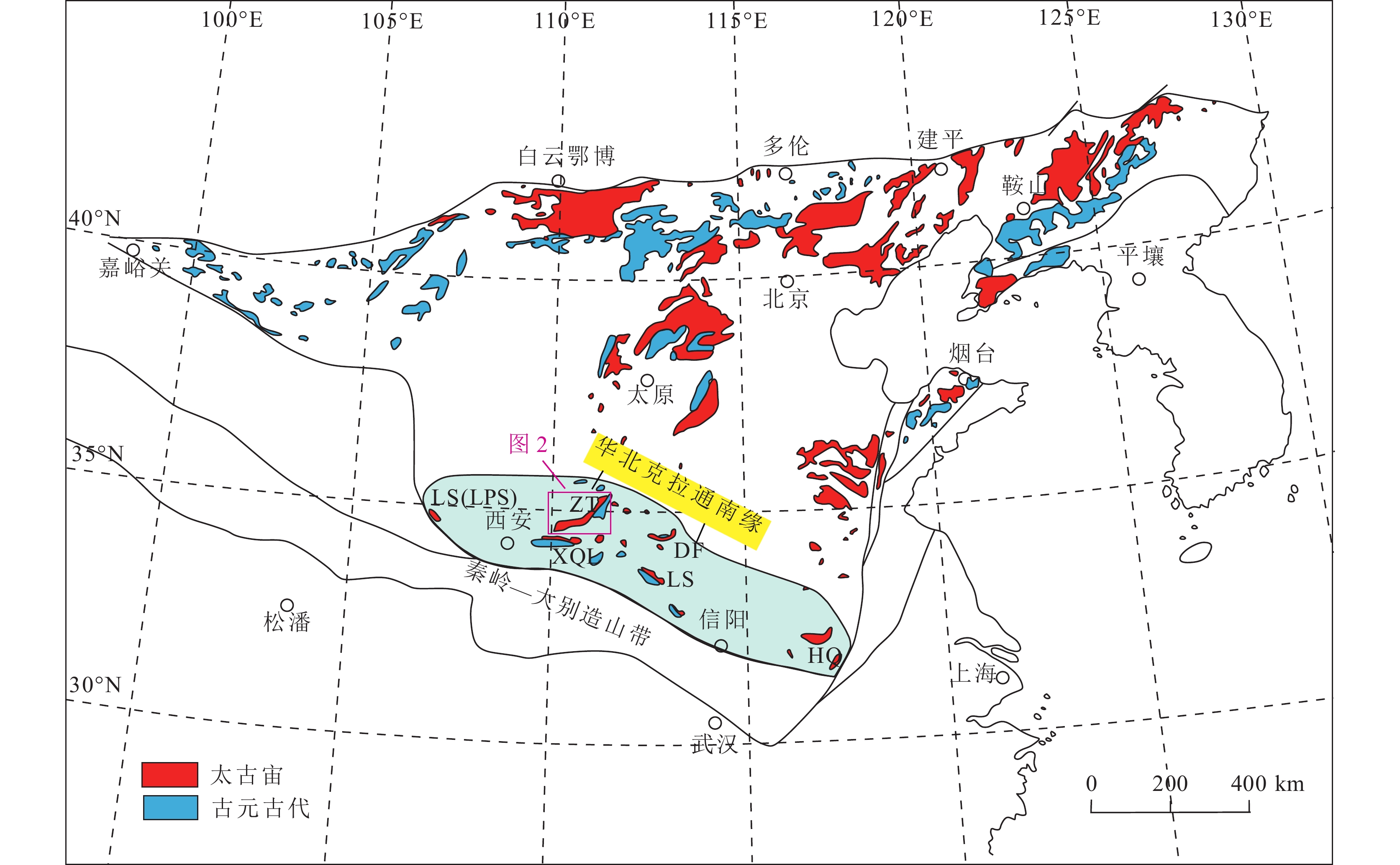
 下载:
下载:
